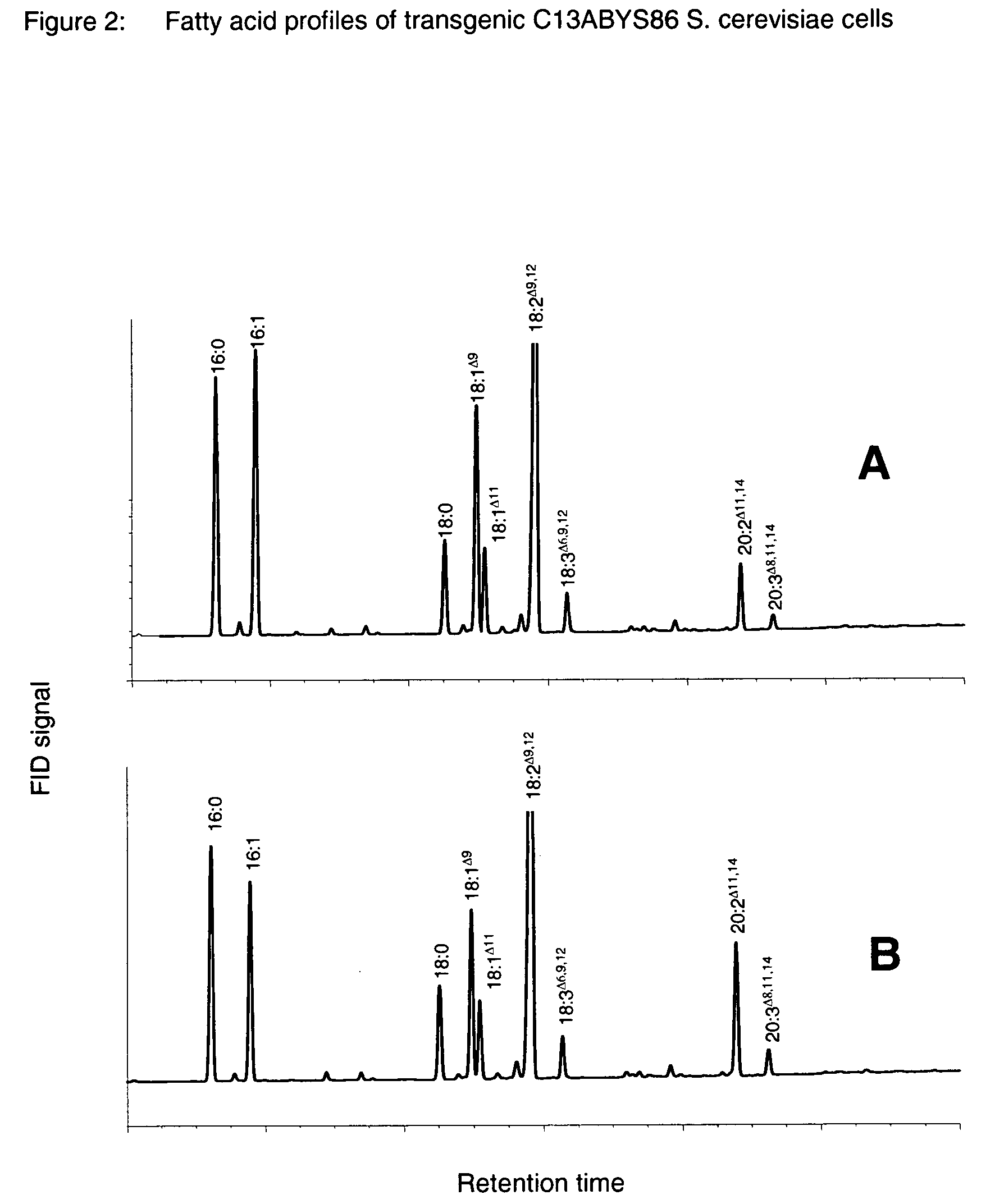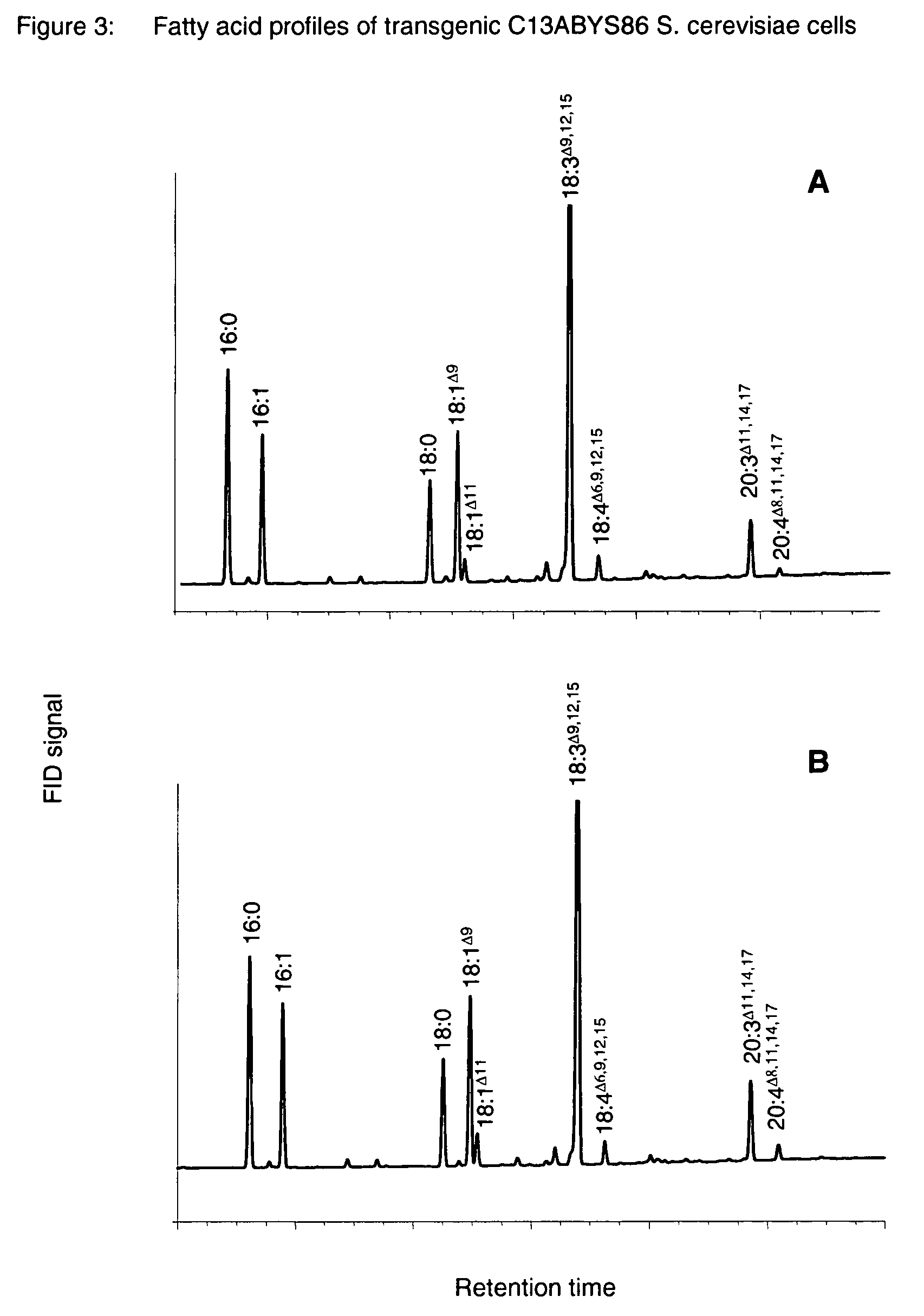Method for the production of polyunsaturated fatty acids
- Summary
- Abstract
- Description
- Claims
- Application Information
AI Technical Summary
Problems solved by technology
Method used
Image
Examples
example 1
General Methods
a) General Cloning Methods:
[0174]Cloning methods such as, for example, restriction cleavages, agarose gel electrophoresis, purification of DNA fragments, transfer of nucleic acids to nitrocellulose and nylon membranes, linking of DNA fragments, transformation of Escherichia coli and yeast cells, cultivation of bacteria and sequence analysis of recombinant DNA were carried out as described in Sambrook et al. (1989) (Cold Spring Harbor Laboratory Press: ISBN 0-87969-309-6) or Kaiser, Michaelis and Mitchell (1994) “Methods in Yeast Genetics” (Cold Spring Harbor Laboratory Press: ISBN 0-87969-451-3).
b) Chemicals
[0175]Unless stated otherwise in the text, the chemicals used were obtained in analytical-grade quality from Fluka (Neu-Ulm, Germany), Merck (Darmstadt, Germany), Roth (Karlsruhe, Germany), Serva (Heidelberg, Germany) and Sigma (Deisenhofen, Germany). Solutions were prepared using purified, pyrogen-free water, referred to as H2O hereinbelow, from a Milli-Q Water Sy...
example 2
Cloning and Characterization of the ceLPLATs
a) Database Search
[0219]The ceLPLATs (=acyl-CoA:lysophospholipid acyltransferase from Caenorhabditis elegans) were identified by sequence comparisons with known LPA-ATs. The search was restricted to the nematode genome (Caenorhabditis elegans) with the aid of the BLAST-Psi algorithm (Altschul et al., J. Mol. Biol. 1990, 215: 403-410), since this organism synthesizes LCPUFAs. The probe employed in the sequence comparison was an LPMT protein sequence from Mus musculus (MsLPAAT Accession No. NP—061350). LPLAT catalyzes, by a reversible transferase reaction, the ATP-independent synthesis of acyl-CoAs from phospholipids with the aid of CoA as cofactor (Yamashita et al., J. Biol. Chem. 2001, 20: 26745-26752). Sequence comparisons enabled two putative ceLPLAT sequences to be identified (Accession No. T06E8.1 and F59F4.4). The identified sequences are most similar to each other and to MsLPAATs (FIG. 1). The alignment was generated using the Clusta...
example 3
Analysis of the Effect of the Recombinant Proteins on Production of the Desired Product
a) Possible Preparation Methods
[0222]The effect of genetic modification in fungi, algae, ciliates or, as described in the examples hereinabove, on the production of the polyunsaturated fatty acids in yeasts, or in plants may be determined by growing the modified microorganisms or the modified plant under suitable conditions (such as those described above) and studying the medium and / or the cellular components for increased production of the lipids or fatty acids. These analytical techniques are known to the skilled worker and comprise spectroscopy, thin layer chromatography, various types of staining methods, enzymic and microbiological methods and analytical chromatography such as high-performance liquid chromatography (see, for example, Ullmann, Encyclopedia of Industrial Chemistry, vol. Δ2, pp. 89-90 and pp. 443-613, VCH: Weinheim (1985); Fallon, A., et al., (1987) “Applications of HPLC in Bioc...
PUM
| Property | Measurement | Unit |
|---|---|---|
| Fraction | aaaaa | aaaaa |
Abstract
Description
Claims
Application Information
 Login to View More
Login to View More - R&D
- Intellectual Property
- Life Sciences
- Materials
- Tech Scout
- Unparalleled Data Quality
- Higher Quality Content
- 60% Fewer Hallucinations
Browse by: Latest US Patents, China's latest patents, Technical Efficacy Thesaurus, Application Domain, Technology Topic, Popular Technical Reports.
© 2025 PatSnap. All rights reserved.Legal|Privacy policy|Modern Slavery Act Transparency Statement|Sitemap|About US| Contact US: help@patsnap.com



